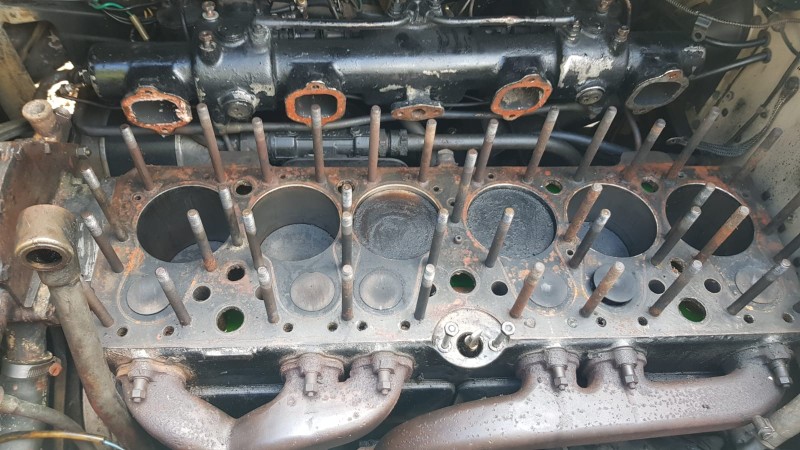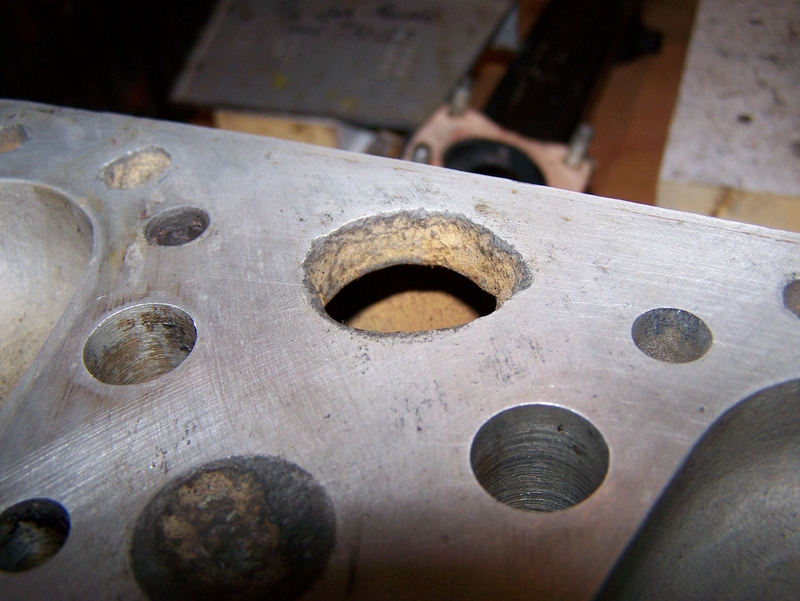| Author | Message | ||
EdwardShoesmith Unregistered guest Posted From: 202.53.37.24 |
Just an off the cuff question I recently removed the head on my 4.5 Ltr B series Engine for general maintenance, discovered there is a fair amount of carbon build up on the cylinder heads and the valves, no great surprise there as I'm reasonably certain the head hasn't been off in years. As Im not in a position to do an engine rebuild till 2024 I have been toying with the notion that after replacing the head to have an engine carbon clean done. With todays technologies it seems to me in the short term this might assist with general performance of the vehicle. Was wondering if anyone else has tried engine carbon cleaning and what was the experience and outcome? (Message approved by david_gore) | ||
Edward Shoesmith Yet to post message Username: younghenri Post Number: 1 Registered: 10-2022 |
Carbon image of cylinders etc  | ||
Jeff Martin Frequent User Username: jeff_r_1 Post Number: 419 Registered: 07-2018 |
That's actually not that much given that it has been a while _ according to you. What happens is excessive oil entering the combustion chamber through worn rings and worn guides/valve stems. There is no indication that any of that is happening. I don't believe you're going to notice any appreciable increase in performance form removing what you see in the photo. If you're going to do something, drop the sump and clean that, check your low pressure oil galleries and the rocker shaft, they have a tendency to get carboned up. Excessive wear on the rocker shaft will happen with very little or no oil flow to the top of the engine. Drain the block if that has not been done for a while, very often nothing will come out the pet-cock dur to silting. You can run a garden hose through the larger coolant ports in the block, being careful not to get water in the cylinders. . | ||
Edward Shoesmith New User Username: younghenri Post Number: 2 Registered: 10-2022 |
Hey Jeff Much appreciate the advice and suggestions Have drained the block previously but will do it again, although I haven't dropped the sump so I will do that to ensure any crap has gone. Its my plan to do the valves guides new pistons and rings etc next year has been bad enough having the head sorted out, trying to find some to do the overhaul who doesnt want to charge the earth is almost impossible, seems no one wants to work on old cars or business is so good they don't want my business unless its an open cheque book. Maybe my perception is wrong who knows just seems to me that mention the Word Bentley and Rolls Royce to any mechanic and they automatically think its Christmas for them and that the owner must be an idiot. So sick of rip off mechanics - but I digress. Cheers Ed | ||
Bill Vatter Experienced User Username: bill_vatter Post Number: 148 Registered: 09-2004 |
I cannot quite make out from your pictures if the Brichrome part-length cylinder liners are still in there. They are 2-1/4 inch long. Of so, use a dial bore gauge to measure cylinder diameter variation in the area near the bottom of the liner. The liner will not be worn any measurable amount, but the cast iron immediately below it will be worn. The diameter difference, if significant, will cause serious problems, and this will be a good indicator of engine overhaul is in the cards for you. If it's more than 0.005 inch, put this in your plans. If you don't have a dial bore gauge, run your finger across the interface. A sensitive finger should be able to feel the diameter change if it is enough to cause trouble. | ||
Bill Vatter Experienced User Username: bill_vatter Post Number: 149 Registered: 09-2004 |
As Jeff said, it doesn't look very bad. If it was mine, and the cylinders are in good condition, I would close it up, be happy, and go driving. I don't believe in fixing things that aren't broken. A complete engine overhaul will easily cost $20-25 thousand US currency. Sorry I don't know current exchange rate to Au $. There are a lot of reasons for that, and it is not a rip-off. Mostly, it's the labor. The work is very labor-intensive, and also quite variable depending on difficulties encountered. Most competent mechanics will not want to do it because they know they don't know much about it, and will therefore, likely get into trouble doing the job. If they do have experience, they will be reluctant because they know you will be an unhappy customer when they take much longer and charge much more than you want. On the other hand, if you are a really hard-core enthusiast, you might consider doing it yourself. You can learn, and there are people who can help. Working on your car is, at least for me, a very big part of the fun and satisfaction that comes with the hobby. Hey, you already did what is for many, the most difficult part. You got the cylinder head off. The fact that you got it off without great difficulty indicates maybe not much is needing to be reconditioned. | ||
Edward Shoesmith New User Username: younghenri Post Number: 5 Registered: 10-2022 |
Hi Bill Many Thanks for your replies I agree now thanks to people like yourself it probably isn't that bad, but I have read and when in discussion with NON RR&B classic car enthusiasts, eg Jag and MB clubs (which I am member of (not the RR&B ones though)) some have suggested they had indeed had a carbon engine clean, and they had experienced a "notable" increase in performance - of course all of that is subjective I do realise. I guess I was just a little shocked regarding the carbon initially and with not have anything to compare it (either good or bad) it just seemed to me "perhaps" the build up needed to be addressed. As you have suggested I am also not a great believer on fixing problems that don't exist. However since I managed to get the head off it had occurred to me given my car is 70 years old now and with governments actively suggesting the phasing out of combustion engines lets say over the next 20 years, in the interest of preservation I thought given; a. mechanics are becoming harder to find and becoming less interested in classic, vintage and veteran vehicles that now would/might be a good time to consider doing a recon on the engine, so at least it might be around for another 50 years with luck b. Parts are a plenty atm - but who knows what will happen in a decade, if combustion engines are phased out there will be no incentive to continue producing parts. BTW I think your estimate for recondition might be a little over, I would think somewhere between 10-15K AUD is more likely. Unfortunately my skills set would not allow me to consider tackling such a task myself, a I dont have the spare time and B Im not that technical regarding boring etc etc - So I would have the car done elsewhere and provide tha parts myself, which is what I traditionally have done, as I have been burnt way too many time by certain sydney based mechanics, whom will remain unnamed here, but others on here do mention them and lets says there "concerns" about these peoples business practices are more than valid. | ||
Jeff Martin Frequent User Username: jeff_r_1 Post Number: 424 Registered: 07-2018 |
You would not do the boring yourself, or any of the other machining. This is what my machine shop did with mine; they bored and sleeved it back to speck, and got rid of the chimney liners, they had me go to a custom race shop and get new modern short skirt pistons _ modern alloys and rings, and the short skirt does not generate all the friction and heat the long skirt pistons do, the car runs a little cool, so I have to use a hotter thermostat. I used Allice Chalmers tractor bearing and some new holes had to be made for the oil to flow _ quite the savings there. They machined the rocker shaft true and made oversized bearings, but you can get new rocker shafts now, as well as bearings. They didn't touch the cam bearings, as they were so close to tolerance. I assembled it myself, make sure and get the distributor right if you do the engine, many are facing offside, one way or another. All the machining was about 3,000.00$ Canadian, but that was 20 years ago, so I would double that. They found it necessary to grind the crank and use 30 thou over bearings. You may go through the engine and get what parts you need now to be used down the line, if not by you, but the new custodian. I believe that there will always be vintage cars on the road, exceptions will be made, but maybe I'm being too optimistic. We'll be like these guys in a post-apocalyptic movie where we'll all be hoarding fuel, like "Mad Max" !  Incidentally, what's the compression, that would indicate broken rings if it was down to around 60 psi. If that's OK, I'm with Bill, leave it alone ? | ||
Jeff Martin Frequent User Username: jeff_r_1 Post Number: 578 Registered: 07-2018 |
Rather then start a new thread, I'll just ask here. If you look at Edward's engine deck, you will notice piston #3 is clean on the edge on the carb side, while 2, 4 an five are all black. On my engine, only the last 3 piston's at the back were all black, while numbers 1,2 and 3, had clean spots on the carb side in the same area. The clean spots on my engine were considerably larger then on Edward's engine. I've also seen engines where all the pistons were clean in that area, why is that while others are an even black carbon all over ??? Is coolant seeping in from the water jacket in those areas due to corrosion in the head mainly; near those cylinders ? The seeping would be very small, not even enough to affect compression or contaminate the oil, just enough to keep the cylinders clean in these areas. My head gasket and block shows discolouration where coolant may be seeping in, and I don't think it's from the heat of the block. The suspect areas on my head just happens to be where coolant is leaking into the head gasket, and I'm having the head repaired, some areas are quite badly corroded away. Here are some photos of the worst areas that need attention. These are the same photo's from "Copper Spray-A-Gasket" I've spoken to a machine shop, and they're going to "mill" away the corroded parts and press in chamfered aluminum plugs and weld them in. After which things will be machined back to spec.     |